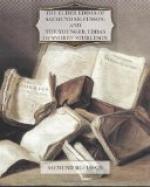Helgi.
46. Nothing I now declare unlooked for, at Sefafioll, late or early, since in a corpse’s arms thou sleepest, Hogni’s fair daughter! in a mound, and thou art living, daughter of kings!
47. Time ’tis for me to ride on the reddening ways: let the pale horse tread the aerial path. I towards the west must go over Vindhialm’s bridge, ere Salgofnir awakens heroes.
Helgi and his attendants rode their way, but Sigrun and hers proceeded to their habitation. The following evening Sigrun ordered her serving-maid to hold watch at the mound; but at nightfall, when Sigrun came thither, she said:
48. Now would he come, if he to come intended, Sigmund’s son, from Odin’s halls. I think the hope lessens of the king’s coming, since on the ash’s boughs the eagles sit, and all the folk to the dreams’ tryst are hastening.
Serving-maid.
49. Be not so rash alone to go, daughter of heroes! to the house of draugs:[58] more powerful are, in the night-season, all dead warriors, than in the light of day.
Sigrun’s life was shortened by grief and mourning. It was a belief in ancient times that men were regenerated, but that is now regarded as an old crone’s fancy. Helgi and Sigrun are said to have been regenerated. He was then called Helgi Haddingiaskadi, and she Kara Halfdan’s daughter, as it is said in the songs of Kara; and she also was a Valkyria.
FOOTNOTES:
[Footnote 54: Slaughtering and carrying off the cattle on the sea-shore.]
[Footnote 55: The Valkyriur.]
[Footnote 56: Dark words of deadly import.]
[Footnote 57: The superstition commemorated In this strophe is, no doubt, the origin of some very beautiful ballads in the later literature of Scandinavia and Germany referring to this superstition:
“When thou, my dear,
art cheerful,
And easy in thy
mind,
The coffin where I slumber
Is all with roses
lined.
But oft as thou’rt in
sorrow,
And bow’d
with grief so sore,
Is all the while my coffin
Brim full of blood
and gore.”
]
[Footnote 58: Probably house of draffs; place of swine, swill, lees.]
SINFIOTLI’S END.
Sigmund Volsung’s son was a king in Frankland. Sinfiotli was the eldest of his sons, the second was Helgi, the third Hamund. Borghild, Sigmund’s wife, had a brother named Gunnar; but Sinfiotli her stepson and Gunnar both courted one woman, on which account Sinfiotli slew Gunnar. When he came home, Borghild bade him go away, but Sigmund offered the blood-fine, which it was incumbent on her to accept. At the funeral feast Borghild presented the beer: she took a large horn full of poison, and offered it to Sinfiotli; who, when he looked into the horn, and saw that there was poison in it, said to Sigmund:




